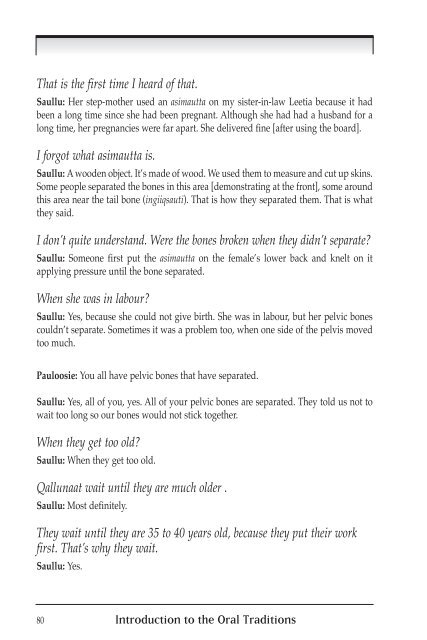Introduction-E
Introduction-E
Introduction-E
You also want an ePaper? Increase the reach of your titles
YUMPU automatically turns print PDFs into web optimized ePapers that Google loves.
That is the first time I heard of that.<br />
Saullu: Her step-mother used an asimautta on my sister-in-law Leetia because it had<br />
been a long time since she had been pregnant. Although she had had a husband for a<br />
long time, her pregnancies were far apart. She delivered fine [after using the board].<br />
I forgot what asimautta is.<br />
Saullu: A wooden object. It’s made of wood. We used them to measure and cut up skins.<br />
Some people separated the bones in this area [demonstrating at the front], some around<br />
this area near the tail bone (ingiiqsauti). That is how they separated them. That is what<br />
they said.<br />
I don’t quite understand. Were the bones broken when they didn’t separate?<br />
Saullu: Someone first put the asimautta on the female’s lower back and knelt on it<br />
applying pressure until the bone separated.<br />
When she was in labour?<br />
Saullu: Yes, because she could not give birth. She was in labour, but her pelvic bones<br />
couldn’t separate. Sometimes it was a problem too, when one side of the pelvis moved<br />
too much.<br />
Pauloosie: You all have pelvic bones that have separated.<br />
Saullu: Yes, all of you, yes. All of your pelvic bones are separated. They told us not to<br />
wait too long so our bones would not stick together.<br />
When they get too old?<br />
Saullu: When they get too old.<br />
Qallunaat wait until they are much older .<br />
Saullu: Most definitely.<br />
They wait until they are 35 to 40 years old, because they put their work<br />
first. That’s why they wait.<br />
Saullu: Yes.<br />
80 <strong>Introduction</strong> to the Oral Traditions


